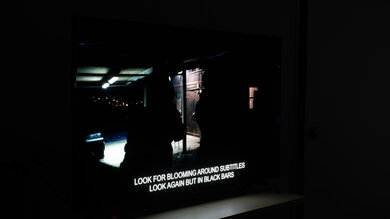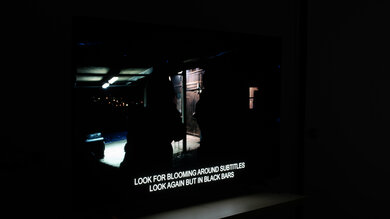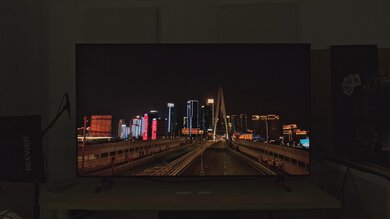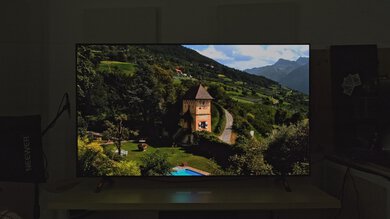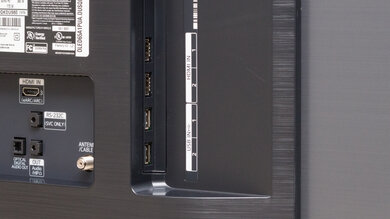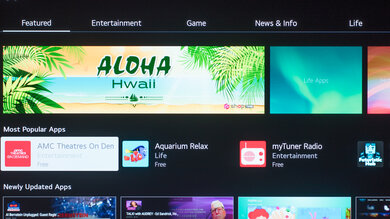The LG A1 OLED is an entry-level OLED released in 2021, sitting below the LG B1 OLED and the more popular LG C1 OLED. It delivers nearly identical picture quality to the higher-end models, but it's limited to a 60Hz refresh rate, lacks HDMI 2.1 bandwidth, and doesn't support variable refresh rate technology (VRR). It runs the same great webOS smart interface, which is fast, easy to use, and has a great selection of additional apps and features. It also comes with the same great Magic Remote, which makes navigating the interface and finding your favorite content a breeze. It's available in a range of sizes from 48 to 77 inches, all of which offer the same features, so you're sure to find something that fits your needs.
Our Verdict
The LG A1 OLED is an excellent TV for pretty much any usage. Deep, inky blacks make it an outstanding choice for watching movies in the dark. The low input lag and nearly instantaneous response times help deliver an amazing experience playing games in SDR or HDR. It's also great for watching sports or TV shows thanks to the wide viewing angles and superb reflection handling, but it can't get very bright, so it's not ideal for a bright environment.
- Near-infinite contrast ratio.
- Nearly instantaneous response time.
- Superb viewing angles.
- Perfect black uniformity.
- Risk of permanent burn-in with static content.
- Not bright enough to overcome glare.
The LG A1 OLED is great for watching TV shows during the day. It has outstanding viewing angles, making it a great choice if you like to walk around with the TV on, and the smart interface has a huge selection of streaming apps. It also has remarkable reflection handling, but, unfortunately, it can't get very bright, so it's not the best choice for a bright viewing environment. The TV also has impressive gray uniformity.
- Superb viewing angles.
- Risk of permanent burn-in with static content.
- Not bright enough to overcome glare.
The LG A1 OLED is a very good TV for watching sports. The nearly instantaneous response time results in very little blur behind fast-moving objects. Although it has outstanding reflection handling, it's not very bright, so it's not a great choice for a brighter environment. On the other hand, the outstanding viewing angles make it a great choice for watching the big game with a large group of friends, and it has impressive gray uniformity.
- Nearly instantaneous response time.
- Superb viewing angles.
- Risk of permanent burn-in with static content.
- Not bright enough to overcome glare.
The LG A1 is an excellent TV for playing video games. The OLED panel has a nearly instantaneous response time, so there's almost no blur behind fast-moving objects, and it has outstanding low input lag for a responsive gaming experience. On the other hand, it can't take full advantage of the PS5 or Xbox Series X, as it doesn't support 4k @ 120Hz gaming, it doesn't support variable refresh rate technology, and it's limited to a 60Hz refresh rate.
- Near-infinite contrast ratio.
- Nearly instantaneous response time.
- Very low input lag.
- Perfect black uniformity.
- Risk of permanent burn-in with static content.
- Doesn't support variable refresh rates or HDMI 2.1.
The LG OLED65A1 is excellent for watching movies in HDR. The nearly-infinite contrast ratio results in perfect blacks with no blooming, without the need for a local dimming feature. It also has an amazing color gamut, with nearly perfect coverage of the DCI P3 color space used by most current HDR content. Unfortunately, it has disappointing peak brightness in HDR, so small highlights in many scenes don't stand out the way the content creator intended.
- Near-infinite contrast ratio.
- Wide color gamut.
- Perfect black uniformity.
- Not bright enough for small highlights to stand out.
- Some stutter in low frame rate content.
- Can't remove judder from all sources.
The LG A1 OLED is an amazing TV for gaming in HDR. It has low input lag for a responsive gaming experience, and a nearly instantaneous response time, so motion looks clear with little blur. It has a nearly infinite contrast ratio and perfect black uniformity, as well as an amazing color gamut, all of which are important for a good HDR experience, but it can't get very bright. Unfortunately, it doesn't support HDMI 2.1 bandwidth, and it doesn't support variable refresh rate technology, so it can't take full advantage of the latest gaming consoles.
- Near-infinite contrast ratio.
- Nearly instantaneous response time.
- Very low input lag.
- Wide color gamut.
- Perfect black uniformity.
- Not bright enough for small highlights to stand out.
- Risk of permanent burn-in with static content.
- Doesn't support variable refresh rates or HDMI 2.1.
The LG A1 OLED is an excellent TV for use as a PC monitor, with some limitations. It has outstanding viewing angles, exceptional low input lag, and a nearly instantaneous response time. It's limited to a 60Hz refresh rate, though, and it doesn't support variable refresh rate technology or HDMI 2.1. Unfortunately, there's a chance of burn-in with static content, and the RGBW subpixel structure causes text clarity issues in some cases.
- Nearly instantaneous response time.
- Superb viewing angles.
- Very low input lag.
- Displays proper chroma 4:4:4.
- Risk of permanent burn-in with static content.
- Doesn't support variable refresh rates or HDMI 2.1.
Changelog
- Updated Sep 26, 2025: We uploaded the latest brightness measurements and uniformity photos for the Accelerated Longevity Test.
- Updated Jul 08, 2025: We uploaded the latest brightness measurements and uniformity photos for the Accelerated Longevity Test.
- Updated Apr 17, 2025: We uploaded the latest brightness measurements and uniformity photos for the Accelerated Longevity Test.
- Updated Feb 11, 2025: We uploaded the latest brightness measurements and uniformity photos for the Accelerated Longevity Test.
Check Price
Differences Between Sizes And Variants
We tested the LG 65-inch A1 (OLED65A1PUA), which also comes in 48-inch, 55-inch, and 77-inch sizes. Note that the last three letters in the model number (PUA in this case) vary between retailers and individual regions, but there's no difference in performance.
| Size | North America Model | EU Model |
|---|---|---|
| 48" | OLED48A1PUA | OLED48A16LA |
| 55" | OLED55A1PUA | OLED55A16LA |
| 65" | OLED65A1PUA | OLED65A16LA |
| 77" | OLED77A1PUA | OLED77A16LA |
If you come across a different type of panel or your LG A1 doesn't correspond to our review, let us know and we'll update the review. Note that some tests like gray uniformity may vary between individual units.
Our unit was manufactured in March 2021, and you can see the label here.
Popular TV Comparisons
The LG A1 is a good cheaper option if you want the impressive picture quality that OLED TVs are known for and don't care about the extra gaming features on the more expensive LG models.
For more options, check out our recommendations for the best OLED TVs, the best 4k TVs for watching movies, and the best TVs on the market.
The LG A1 OLED and the LG C1 OLED deliver very similar picture quality but differ in the extra features available. The C1 is a better gaming TV, with four HDMI 2.1 ports, support for variable refresh rate technology (VRR), and a 120Hz refresh rate. For movie lovers, the C1 is also a slightly better choice, as it can remove judder from any source, and it has an optional Black Frame Insertion feature to help reduce persistence blur.
The LG B1 OLED is a higher-end TV than the LG A1 OLED, so it performs better overall. They deliver similar exceptional picture quality thanks to their OLED panels, and even though the B1 gets brighter, it's not a significant difference. The B1 uses a different screen finish, so it has better reflection handling. The main differences are with the gaming features because the B1 has a 120Hz panel with VRR support and HDMI 2.1 inputs, delivering a better gaming experience. The A1 is limited to a 60Hz panel with no VRR.
The LG A2 OLED is an improvement over its predecessor, the LG A1 OLED. The main difference is that the A2 gets brighter, providing a better HDR experience. It also uses a newer version of the LG webOS platform that has a few extra features like support for user profiles, but other than that, the two TVs are very similar in terms of features.
The LG G2 OLED is much better than the LG A1 OLED. The G2 is a lot brighter, especially in HDR, so bright highlights stand out better. The G2 also has more advanced gaming features, including a higher native refresh rate, a backlight-strobing feature, and variable refresh rate support. All four HDMI ports on the G2 support HDMI 2.1 bandwidth, whereas the A1 is limited to HDMI 2.0 bandwidth. The A1 is a bit more versatile out of the box, as it comes with a stand, whereas the G2 is designed to be wall-mounted and doesn't include one.

We buy and test dozens of TVs yearly, taking an objective, data-driven approach to deliver results you can trust. Our testing process is complex, with hundreds of individual tests that take over a week to complete. Most of our tests are done with specially designed test patterns that mimic real content, but we also use the same sources you have at home to ensure our results match the real-world experience. We use two main tools for our testing: a Colorimetry Research CR-100 colorimeter and a CR-250 spectroradiometer.
Test Results

The LG OLED65A1PUA has a very similar design to the LG C1 OLED, but the stand is different, with two v-shaped feet similar to the LG UP8000.
The back of the TV is plain, and unfortunately, there's no cable management. Like the LG C1 OLED, the top half is metal, but the thicker bottom portion that houses the electronics is plastic. Most of the inputs face to the side and are easy to access, but there are a few less commonly used inputs that face straight back from the TV, and these are very difficult to access, especially when the TV is wall mounted.
Overall, the LG A1 has excellent build quality. The display portion of the body is metal and feels well-built. The section that houses the electronics is plastic but seems to be well-built. The plastic stand feels a bit weaker than the solid stand on the other models, like the LG C1 OLED, making the overall package of the A1 feel a bit less premium.
Unfortunately, the LG A1 has disappointing HDR peak brightness. Although it tracks the EOTF correctly, displaying most scenes at the correct brightness, it peaks at a low brightness level and rolls off gradually. It's not bright enough for most HDR content, and small highlights don't stand out as well as the content creator intended. Like all OLED displays, there's a fair amount of variation in brightness depending on the scene due to the Automatic Brightness Limiter (ABL). If you find this distracting, setting Peak Brightness to 'Off' results in almost all scenes being displayed at about 370 cd/m². Even with this off, very bright scenes are dimmed considerably, dropping as low as 111 cd/m² with a sustained 100% bright window.
These measurements are with the default settings in the 'Cinema' Picture Mode, with Brightness and Contrast set to max, Peak Brightness on 'High', and Color Depth set to '50'. All other picture processing settings were left disabled. If you want to make HDR brighter, enable HDR Tone Mapping and set Auto Dynamic Contrast to 'High', which can help as seen in this EOTF.
To get the brightest possible image at the expense of picture quality, use the 'Vivid' Picture Mode, enable HDR Tone Mapping, and set Auto Dynamic Contrast to 'High', and leave the other settings as mentioned above. The TV reaches a peak brightness of 625 cd/m² in the 2% window using these settings.
Switching to Game Mode makes no noticeable difference to the peak brightness, which is great. These results are with the same picture settings as outside of Game Mode.
The LG A1 has mediocre brightness in SDR. It's noticeably less bright than the LG C2 OLED. Like all OLED displays, there's a fair amount of variation in brightness depending on the scene due to the Automatic Brightness Limiter (ABL). If you find this distracting, disabling the Peak Brightness setting results in almost all scenes being displayed at about 230 cd/m². There's almost no variation in peak brightness with that setting, but it's too dim to overcome glare in a bright room. If you want something brighter, then look into the LG A2 OLED.
These measurements are with the full calibration settings, using the 'Expert (Dark space, night)' Picture Mode, Color Depth set to 'Warm 50', and Peak Brightness set to 'High'.
If you want an even brighter image and don't care about accuracy, set the Picture Mode to 'Standard', set Brightness and Contrast to max, Peak Brightness to 'High', and Auto Dynamic Contrast to 'High'. It reaches a peak of 458 cd/m² with a 2% window using those settings.
The LG A1 has an excellent color gamut, with almost perfect coverage of the DCI P3 color space used by the majority of HDR content currently available and good coverage of the wider Rec. 2020 color space. It also has good tone mapping in both color spaces, ensuring that fine details in areas of bright saturated colors are preserved.
The LG A1 has good color volume. Due to the extra white subpixel, colors aren't as bright as pure white. Thanks to the nearly infinite contrast ratio, dark saturated colors are properly displayed.
The LG A1 we tested has good accuracy in SDR out of the box. All colors are slightly inaccurate, but most people won't notice it. The white balance is the biggest issue, affecting mainly brighter shades of gray, and the color temperature is a bit cold, giving everything a slightly bluish tint. Gamma is a bit higher than the 2.2 target we use for a moderately lit room, as most scenes are darker than they should be.
The LG A1 was very easy to calibrate. After calibration, the white balance is nearly perfect, and gamma tracks our target of 2.2 almost perfectly. The color temperature is very close to our target, and any remaining inaccuracies in colors aren't noticeable.
You can see our full calibration settings here.
The LG OLED65A1 has great gray uniformity, but some bands appear slightly different from the rest of the screen. These aren't noticeable with regular content. In near-dark scenes, it's a bit better, but like all OLEDs we've tested, there are some faint vertical lines. These aren't noticeable unless you're looking for them.
The LG OLED65A1PUA has superb reflection handling. However, it's noticeably worse than the LG C1 OLED. The semi-gloss screen finish doesn't diffuse reflections as well as the glossy coating on the LG C1 OLED.
The LG A1 uses a WRGB subpixel structure. Like other OLEDs, all four subpixels are never lit at the same time. This image shows the red, white, and blue sub-pixels. You can see an alternate photo with the green, red, and white subpixels lit here.
The LG A1 has an outstanding response time, but it does behave a bit differently from the other 2021 LG OLED TVs, including the LG C1 OLED. Transitions from dark scenes to bright scenes are significantly slower than usual, causing a bit more noticeable blur behind fast-moving objects. That said, it's still fantastic, and there's almost no noticeable blur behind fast-moving objects. Due to the panel's sample-and-hold technology, though, there's more persistence blur due to the fast response time.
Like all OLED displays, the LG 65A1 isn't quite flicker-free, as there's a small decrease in brightness that corresponds with the refresh cycle of the display. It's very different from pulse width modulation flicker (PWM) on TVs with LED backlights, as the entire screen never dims at once.
Unlike the rest of LG's OLED lineup, the LG A1 OLED doesn't have a Black Frame Insertion (BFI) feature.
The LG A1 OLED has an optional motion interpolation feature, which reduces the amount of stutter when watching low framerate content. Unfortunately, it doesn't perform very well, with significant artifacts and haloing in action scenes.
Due to the slightly slower response time on the LG 65A1, there's a bit less stutter than the other OLED displays we've tested, like the LG C2 OLED or the Sony A90J. It's still noticeable when watching movies, especially in slow panning shots.
The LG A1 can only remove judder from 24p sources and the native apps. It's different from the other LG OLEDs we've tested and is likely due to the 60Hz refresh rate.I
Unlike the LG C1 OLED, the LG A1 is limited to a 60Hz refresh rate, and it doesn't support variable refresh rate technology, so it's not as versatile for gaming, and you'll see more flickering and tearing in some games.
The LG A1 has outstanding low input lag, resulting in a very responsive gaming experience.
The LG A1 supports many common formats, but only at 60Hz, as it can't refresh faster than that. Although it'll accept a 120Hz 1080p signal, it just skips every other frame. All supported formats can display chroma 4:4:4 properly, which is essential for clear text from a PC, but a 4k 60Hz signal can only display chroma 4:4:4 in SDR with 8-bit color due to the bandwidth limitations of the HDMI ports on this TV.
The LG A1 OLED only supports a 4k @ 60Hz input from the next-generation consoles, as it lacks the HDMI 2.1 ports necessary for higher refresh rates. Although the TV exposes that it can accept a 120Hz signal at 1080p, it just skips every other frame, resulting in a 60Hz image.
There's no composite input, even with an adapter.
The LG A1 supports eARC, meaning it can pass most high-quality audio formats to a connected receiver or soundbar. It doesn't support DTS or DTS:X, though, which is disappointing, as many Blu-rays use DTS for the main audio format. If you have a UHD Blu-ray player, it might be best to connect it directly to your receiver instead of using eARC.
The LG A1 has an okay frequency response. The low-frequency extension (LFE) is okay, but like most TVs, the bass lacks thump or rumble. Above the LFE, the sound profile is balanced, resulting in clear dialogue. It can get loud, but there's a bit of compression at higher volume levels.
Unfortunately, although the overall distortion is acceptable, at max volume, there's significant intermodulation distortion. It varies depending on the content, though, and not everyone will even notice it.
The LG A1 runs the same webOS smart interface as the LG C1 OLED. Instead of the dual ribbons found on 2020 models, the Home hub is now full screen, with emphasis placed on rows of suggested content, connected devices, and apps. The interface is easy to use and very responsive, and we didn't notice any issues with it during testing.
LG has finally updated the design of the Magic Remote, which had remained virtually unchanged for a few years. The new remote is slimmer but has the same great features as the previous model. The remote has built-in voice controls and can be used to change inputs, search for content, or search the web.









